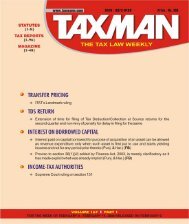news round up - Taxmann
news round up - Taxmann
news round up - Taxmann
- TAGS
- news
- round
- taxmann
- taxmann.com
Create successful ePaper yourself
Turn your PDF publications into a flip-book with our unique Google optimized e-Paper software.
116 GOODS & SERVICES TAX - MAGAZINE [Vol. 1<br />
New Zealand innovation, the zero rating of business-to-business<br />
financial services in 2003. In comparison to the much older and far<br />
more often amended income-tax, this young tax appears to be static<br />
and local - even parochial, at times - as well as being less litigated,<br />
researched and taught.<br />
Considerable time was spent in developing the initial framework for GST<br />
in New Zealand. Hence, there have not been many amendments since the<br />
initial enactment. Amendments have been made to remedy in unforeseen<br />
circumstances or to clarify policy issues.<br />
GST in New Zealand has proved to be efficient and, by and large, a<br />
problem-free tax to administer. It contributes substantial revenue to the<br />
Government. India needs to take lessons from New Zealand to ensure that<br />
a robust GST is enacted taking care to avoid ambiguities in drafting the<br />
law so that the Act may not get involved in litigation from the very<br />
beginning.<br />
2.3 CANADIAN GST - The Canadian Goods and Services Tax (GST) is a multilevel<br />
value-added tax introduced in Canada on January 1, 1991. The GST<br />
replaced a hidden 13.5 per cent Manufacturers’ Sales Tax (MST). The GST<br />
was implemented because the MST hurt the manufacturing sector’s<br />
ability to export. The introduction of the GST was very controversial. As<br />
of January 1, 2008, the GST currently stands at 5 per cent. There is a 5 per<br />
cent tax on all products, except certain essentials such as groceries,<br />
residential rent, and medical services, and services such as financial<br />
services. The tax is levied on each sale. Businesses that purchase goods and<br />
services as inputs can claim ‘input tax credits’ (i.e., they deduct the amount<br />
of GST they have collected from the amount of GST that they have paid).<br />
This avoids ‘cascading’ (i.e., the application of the GST on the same goods<br />
or service several times as it passes from business to business on its way<br />
to the final consumer). In this way, the tax is effectively borne by the final<br />
consumer. Unfortunately, this system is not completely effective, as<br />
shown by criminals who defrauded the system by claiming GST input<br />
credits for non-existent sales by a fictional company. Exported goods are<br />
exempt (‘zero-rated’), while individuals with low incomes can receive a<br />
GST rebate calculated in conjunction with their income-tax.<br />
In 1997, the provinces of Nova Scotia, New Brunswick and Newfoundland<br />
and Labrador and the Government of Canada merged their respective<br />
sales taxes into the Harmonized Sales Tax (HST). In those provinces, the<br />
current HST rate is 13 per cent. HST is administered by the federal<br />
Government, with revenues divided among participating Governments<br />
according to a formula. All other provinces continue to impose a separate<br />
sales tax at the retail level only, with the exception of Alberta, which does<br />
not have a provincial sales tax. In PEI and Quebee, the provincial taxes<br />
include the GST in their base. The three territories of Canada (Yukon,<br />
Northwest Territories and Nunavut) do not have territorial sales taxes.<br />
The Government of Quebee administers both the federal GST and the<br />
GOODS & SERVICES TAX CASES ❑ JANUARY 20 - FEBRUARY 4, 2010 ◆ 26











![“FORM NO. 3CEB [See rule 10E] Report from an ... - Taxmann](https://img.yumpu.com/45480232/1/190x245/form-no-3ceb-see-rule-10e-report-from-an-taxmann.jpg?quality=85)





